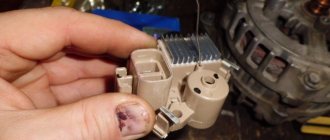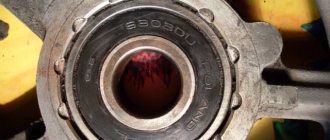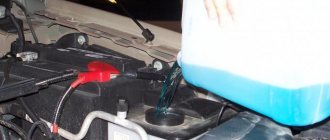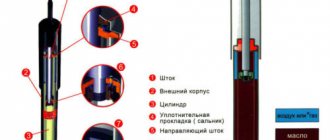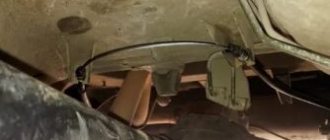Replacing generator brushes on a VAZ 2107
see also
Generator malfunctions - signs, diagnostics, causes, testing
- 806 13 669k
Generator overrunning clutch
- 27 9 20k
How to eliminate a whistling alternator belt
- 253 1 240k
If the alternator belt breaks on the road
- 108 0 98k
How to check the generator
- 190 1 197k
Current to power conversion calculator
Convert how many amperes a kW has online. Calculator for converting current amperes to power watts
VAZ 2107/2105 cars have two types of generators: early models are equipped with a G-222 generator, and later models are equipped with a 37.3701 generator. In terms of their characteristics, they are almost identical, therefore they have interchangeable parts. Their differences are only in different power (G-222 produces 700 W, and 37.3701 - 770 W), in the wires of the stator winding and in different relay regulators, the brushes are the same and also change.
Signs of brush failure on a VAZ 2107 / VAZ 2105 generator
In the event of a generator malfunction, the vehicle's electrical system provides a breakdown indication. When the generator is faulty, the battery lamp icon lights up. But you need to take into account that the cause of the breakdown may be a banal failure of the fuse in the circuit , therefore, after checking the fuse, you must further continue troubleshooting by checking the brushes, rectifier, and voltage regulator.
To check the voltage regulator, you need to connect a voltmeter to the brushes. We connect the “plus” from the 12V battery to the regulator terminal, and connect the “minus” to the “ground” terminal. If there is no voltage, then the regulator is defective and requires replacement.
Sometimes a malfunction or imminent failure of the brushes is indicated by a disruption in the current supply to the car's power supply : the light of lighting fixtures and headlights disappears or dims, the cigarette lighter or radio stops working, the stove stops heating, or the battery discharges too quickly.
Tips for replacing generator brushes VAZ 2107 / VAZ 2105
If you are sure that it is necessary to replace the brushes of the VAZ 2107 injector generator, then you can change them yourself and without removing the generator. To do this, turn off the power to the battery, unscrew the two screws of the brush assembly holder and change the assembly. In another case, when it is not possible to unscrew the bolts or you need advanced diagnostics of the serviceability of generator parts, it is necessary to remove the generator.
It is forbidden to start a car generator with a disconnected battery. This will lead to a short-term increase in voltage at terminal “30”, as a result of which the parts of the rectifier and the vehicle’s electrical network will become unusable.
To replace the brushes of the VAZ 2107 carburetor generator you will need the following tools:
- ring wrenches for “8”, “13”;
- ratchet;
- a set of nozzles “for 13”, “for 10”, “for 17”; "at 19";
- flat and Phillips screwdriver;
- penetrating fluid WD 40;
- vice (if needed);
- new brushes for the VAZ 2107 generator.
The price of brushes VAZ 21013701470 is 34 rubles. Their analogue from UTM with article number HE0703A is 120 rubles.
The price is relevant for Moscow and the region for the summer of 2021. Since then, original brushes have risen in price by an average of only 23 rubles. In 2020, their cost is approximately 57 rubles. The frequently used analogue has risen in price by 40 rubles, and its cost is on average 160 rubles.
A problem in the power supply system is indicated by the battery charging arrow. This indicates that when the engine is running, the battery is not charging well.
The voltmeter showed a voltage of 11.2 volts. Ultimately, suspicion falls on the generator.
Let's start the renovation. First, remove the terminals and remove the battery.
Reasons for overcharging
A malfunction of the relay regulator is the most common cause of battery overcharging.
Due to a breakdown, this unit ceases to perform its functions and “passes” all the voltage generated by the generator into the on-board circuit, and it can reach 25 V. Naturally, not a single electrical appliance in a car is designed for such a voltage, so the elements of the on-board network begin to burn out .
Regulator failure can be partial or complete. In the first case, this element still performs its functions, but “passes” a voltage slightly higher than needed (for example, 15 V).
In this case, the overcharge of the battery can only be detected by readings from measuring instruments or the on-board computer. Electricity consumers practically do not “suffer” from such voltage, but even such an overcharge negatively affects the condition of the battery - with a constant process, the battery “boils out” and fails.
If the relay-regulator is completely malfunctioning, high readings (over 16 V) begin to damage consumers - light bulbs and fuses burn out first, then other devices. A significant excess of voltage can cause a fire in the electrical wiring.
Despite the fact that a partial breakdown of a relay does not pose a significant threat to the vehicle’s on-board network (with the exception of the battery), it should not be ignored, since at any moment it can develop into a complete failure of the element.
Since the relay-regulator is the only element that prevents the battery from overcharging, many car enthusiasts, when they detect increased voltage in the on-board network, immediately replace this unit.
But installing a new regulator does not always help; often the problem remains. Naturally, suspicion in this case falls on the generator. This unit can actually overcharge in the event of a breakdown of the diode bridge or a break in the windings, or a breakdown of the armature to the housing.
READ ON THE TOPIC: Car generator voltage, normal at idle and under load.
But if replacing the regulator relay does not help, you should not immediately change or send the generator for repair.
IMPORTANT: Often the reason for overcharging the battery lies in poor contact of the wiring of the battery charging system circuit (described above).
The reason is very simple: at the point where the contacts are oxidized, resistance arises, which the relay-regulator “perceives” as a load in the on-board network. For example, this can happen in the fuse box.
To compensate for it and prevent a drop in voltage, the regulator begins to “pass” large values, resulting in an increased voltage being supplied to the battery.
Therefore, in searching for the cause of battery overcharging, you should first check the relay-regulator, then the charging system circuit (all connections, as well as the fuse), and only after that remove and diagnose the generator.
Replacing the generator voltage regulator on VAZ 2113, VAZ 2114, VAZ 2115
Welcome! Voltage regulator - it is present in any generator on any car, thanks to it the voltage in the on-board network does not jump and stays even, also thanks to it the voltage in the on-board network does not go too high (The higher the voltage in the on-board network, the faster the wiring will burn out) and as it should be within normal limits (Basically for all cars, the norm is 13.2-14.7 volts in the car’s on-board network), this voltage is enough for the battery to charge and for other devices to still light up (The more devices in the car you turn on, the voltage and will become stronger, thanks to the same voltage regulator), when the regulator becomes unusable, the first thing that begins is a problem with the voltage and, in connection with this, a problem with the wiring occurs, for example, if the regulator suddenly stops restraining the voltage then it will rise to high marks, then the wires will begin to melt first, but if you have all the fuses for the required amperes, then there is nothing to be afraid of, you’ll just change the fuses every five minutes when the voltage jumps and this will continue until you change the regulator to a new one (But this may not be from him, fuses in general can blow out for various reasons, one of the most striking is water getting on the wiring, after which the fuse immediately blows).
Typical faults
Like any other device, a generator tends to break down sooner or later. If it fails, charging is lost and the engine continues to operate only using the battery.
But after a while the battery runs out, and you won’t be able to drive much without a working generator - the car will stall and then won’t start.
The GAZ 53 generator is characterized by the following malfunctions:
- Noise in bearings. At the same time, charging is going on, but it’s not worth driving for a long time with noise. Sooner or later, bearings may seize or fall apart. On the road, a faulty generator causes a lot of trouble for the vehicle owner;
- Breakdown of the diode bridge. Charging disappears and the diode bridge must be replaced. There is no point in repairing the unit - on a GAZ 53 car it is inexpensive, and it is always sold assembled;
This is what the generator diode bridge for GAZ 53 looks like
It is also common for brushes to have poor contact with the armature commutator. The contact may become oily, the brushes do not press well due to weakened springs of the brush assembly, and the commutator itself wears out.
You can try to tighten the springs; wipe the oily contact with a clean rag soaked in solvent. A worn manifold is turned on a lathe if it can still be repaired.
This is what the generator installed on a GAZ 53 looks like
Tips for use
The MAZ car generator must be checked periodically. When using, adhere to the following rules:
- Do not check the condition of the MAZ generator circuits with a light bulb or megohmmeters with a voltage of more than 26 V;
- Do not inspect the unit by shorting the terminals;
- Do not disconnect the wires from the terminal, as well as the battery, while the unit is running.
According to the MAZ generator connection diagram, polarity is strictly observed. Belt tension is checked only after stopping the engine and battery.
Be careful when washing your car. Therefore, make sure that water does not get into the part. Otherwise, over time, breakdowns will occur, which will lead to the repair of the spare part.

